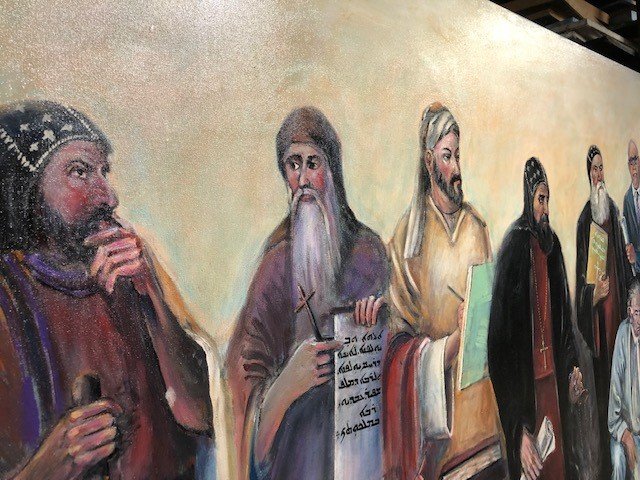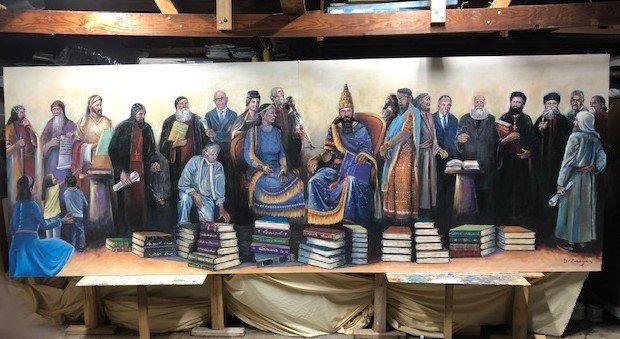Beauty, Knowledge, and Inspiration



The latest paintings of Dankha Zomaya.
By Dr. Robert DeKelaita
It seems impossible to a reasonable person; however, Dankha Zomaya is an artist and exceptional artists have exceptional vision.
In his painting, “A Gathering of Scholars,” he portrays a gathering of the greatest scholars of Akkadian and Syriac literature and science, from King Ashurbanipal in the seventh century before Christ, down to Hanibal Alkhas, an Assyrian artist from Iran.
The painting, to be housed in the Chaldean Community Foundation, portrays King Ashurbanipal seated next to Naqia Zakutu. Naqia was the wife of King Sennacherib, the mother of King Esarhaddon, and the grandmother of Ashurbanipal. She was an intelligent and literate woman whose voice we have heard through the ancient clay tablets found in the famous Ashurbanipal Library of Nineveh.
Standing to the left of the King is the famous, ‘Ahiqar the Wise,’ the trusted advisor of King Sennacherib. To the left and right of the king are noted scholars and men of learning, such as Mar Aprem the Great, who is one of the most respected figures in Syriac literature, Mar Narsai, ‘Harp of the Spirit,’ known for his inspirational spiritual works, Mar Toma Oddo, author of the Syriac Lexicon, Mar Ogin (Eugene) Manna, bishop and author of the prolific Syriac-Arabic dictionary, and Addai Alkhas, editor of one of the most productive newspapers in Syriac in Iran, named Gilgamesh. The scholars stand in reverence of the ancient king, all together as if in an intellectual meeting devoid of time and space. Before them are two children rushing from their mother’s arms to touch the ancient scholars.
“I want to see my people fully understand and appreciate their history,” says Dankha, “and these paintings will spark that drive.”
Dankha’s works come out of a small old garage near Chicago, located next to his modest home. The garage is full of tools, implements, brushes, paints, plaster, wood, and metal; there are lifelike sculptures of bishops and patriarchs, paintings of his ancient ancestors, and strange abstract figures in metal that are full of human movement and expression.
In another painting, “Life from Ruins,” he pays homage to the Pope’s recent visit to Iraq. This is a reminder of his culture and heritage. Next to the Pope is a partially destroyed church in the Nineveh Plain. But always, according to Dankha, there is cause for hope. The church that is destroyed seems to come together. On a stone, in Syriac, is a hymn of praise for God as a reminder that all things are possible in faith.
In his third mural, “Harps of Old and New,” Dankha portrays children and their teachers learning music while ancient figures loom large above to inspire them from long ago. Music was very important in ancient Mesopotamia, Dankha notes. “I hope that every child that plays an instrument realizes the debt he or she owes to our ancestors.”
The three paintings, along with others in the Foundation, tell a story of an ancient people, known as Chaldeans or Syriacs or Assyrians, with a history that spans the entirety of civilization. Tormented and driven from their homeland, they still cling to and are inspired by the treasures of their ancestors, coming from a small old garage near Chicago.
